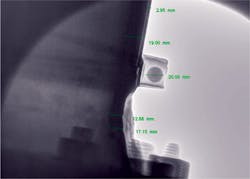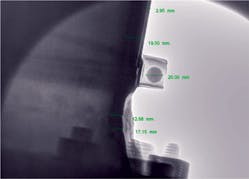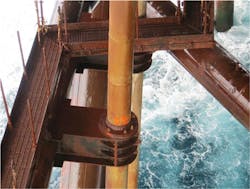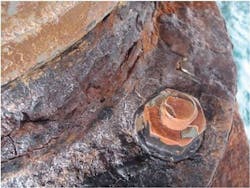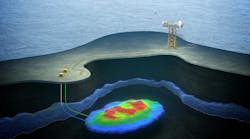James McNab
Oceaneering International, Inc.
A new approach to non-destructive testing (NDT) of large-diameter risers recently enabled an operator to maintain reliable and safe production from an aging offshore platform.
Extending the useful life of decades-old facilities - while assuring system integrity and safety - is an important objective for operators in theNorth Sea, Gulf of Mexico, and other mature producing areas. In this example, an operator needed an NDT method to inspect two risers on a North Sea platform. The risers developed significant external corrosion scale - also known as scabbing - over a number of years until, in January 2016, it was decided to verify the risers’ integrity in preparation for fabric maintenance. The operator wanted to keep the risers - a 24-in. outer diameter (OD) main oil line riser and a 20-in. OD gas producer - in service for another year and needed to confirm fitness for service to allow for repairs that would enable use until the cease of production date.
Integrity verification
Without verification that the risers were fit for service (FFS), the corroded pipe posed potential risks to personnel and the environment. To demonstrate FFS, the operator needed to acquire accurate cross-section profiles of the pipe and measure the remaining wall thickness around the full 360° circumference of the two risers. The large amount of external scale on the risers prevented direct access to the pipe surface, but its removal was not feasible because of the potential of punctures and consequent product release and health, safety, and environmental issues. The area needing inspection, just 39 ft (12 m) above the water’s surface at the lowest astronomical tide, was below the platform deck and was difficult to reach. There was no obvious conventional, industry-accepted NDT method or hardware capable of completing this inspection, and the operator contactedOceaneering International, Inc. to provide a solution.
After reviewing a number of possible methods to conduct the inspection, project engineers concluded that radiography had the best chance of providing the needed measurements. However, traditional x-ray or gamma ray sources did not have sufficient energy to inspect such large-diameter, heavy wall thickness pipe in an offshore environment.
Combined NDT solution
Measuring the risers’ 360° wall thickness required taking tangential x-ray images around the circumference of each pipe. While tangential x-ray imaging is a standard technique, penetrating the very thick “chord” lengths of the risers required very powerful equipment and taking multiple-angle exposures to ensure full area coverage.
Oceaneering recommended a 7.5 MeV PXB betatron with a GE DXR 250U digital detector array (DDA) to perform the riser inspections and provide near real-time measurements of pipe thickness. The betatron - a very high-energy, deep penetrating source of X-radiation - had never been used offshore in conjunction with a DDA. To implement this novel solution, a team comprised of personnel from both the operator and the contractor prepared a detailed project plan, including onshore technical trials, extensive safety planning, electrical, scaffolding, and rigging design and implementation, as well as development of customized hardware.
Onshore testing
Using high-energy x-rays offshore was unprecedented, so onshore testing was required to demonstrate that the inspection could be performed safely and provide the required measurements. In February 2016, x-ray trials were conducted in a special facility in Rosyth, UK, using the planned tangential technique on a 24-in. OD pipe with manufactured representative flaws. After completing the offshore testing, Oceaneering engineers visited the platform to familiarize themselves with the environmental conditions and physical layout and communicate with the operator’s senior management team, the offshore installation manager, HSE representatives, and scaffolding experts. This visit introduced platform personnel to the inspection concept, and enabled the inspection team to plan the work while defining the safe controlled area, principle exposure directions, electrical, telemetry, cable routes, and risk assess the work.
Radiation safety
Radiation safety was the primary challenge. The team prepared a comprehensive health and safety plan with exclusion areas to ensure that personnel were not exposed to radiation. The plan also included detailed radiation dose profiling (with the beam directed toward the high-risk areas of the platform) along with special monitoring instruments and customized radiation collimators to reduce radiation dose.
Custom hardware
To enable precise radiography in this unique application, Oceaneering designed and manufactured a project-specific trolley and a radiation beam angle guide that interfaced with the rim surface of the pipe flange. This hardware assured that each exposure was on target, providing a comprehensive data set of pipe thickness measurements.
The project team designed and erected a custom-engineered scaffold system placed around the risers below the platform deck. The work area, just 39 ft (12 m) from the sea, had to be weatherproofed to protect equipment from moisture, sea salt, and spray. X-ray head and detector cables had to be carefully routed in terms of distance to ensure no power or telemetry drop-out. The team’s rigging crew arranged a twin-wire system to lower the equipment from the deck level through a floor grating hole to the scaffold. Local positioning of the 220-lb (100-kg) accelerator head and collimation was performed using the custom trolley and an overhead lifting beam.
Project execution
In May 2016, offshore preparation was complete and the radiography crew was mobilized. The inspection was conducted during two visits over four weeks, and was completed in June. The project was conducted safely without any radiation, health, safety, and environmental incidents. The acquired images were adequate to distinguish the external surface profile and obtain quantitative metal loss results, clear and unambiguous enough to be used as inputs to fitness-for-service assessment and finite element modeling. The inspection results and calculations confirmed that the risers were fit to continue production at specified pressures until the operator’s scheduled platform maintenance. This NDT solution provided integrity assurance and significant cost savings in a busy operational environment without interrupting production.
Many long-serving platforms in the North Sea, Gulf of Mexico, and other areas face similar corrosion issues in which pipe and structural integrity must be verified. The success of this project demonstrates that the combination of high-energy x-rays with a digital detector array can be an effective option for conducting difficult inspections on these assets.
